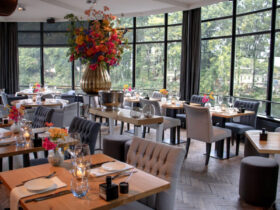The Manaslu region in central Nepal is a trekking destination that has been gaining popularity in recent years. The region is home to the eighth-highest mountain in the world, Mt. Manaslu, and offers a wide range of trekking options, from short hikes to challenging high-altitude expeditions. In addition to its stunning mountain scenery, the Manaslu region is also known for its rich wildlife and biodiversity. In this article, we will explore the different types of wildlife and biodiversity found in the Manaslu region.
Flora:
The Manaslu region of the Himalayas is known for its diverse and stunning flora. The lower elevations of the area are covered by dense forests of rhododendron, oak, and pine trees. These forests are beautiful and provide essential habitats for many wildlife species. As you climb higher, the woods give way to subalpine and alpine meadows, where you can find a variety of wildflowers and grasses. These vibrant colors characterize these meadows and are a beautiful sight to behold.
The Manaslu Conservation Area is home to over 2,000 species of plants, including rare and endangered species such as the Himalayan yew and the blue poppy. The conservation area is also home to medicinal plants, some used in traditional Nepalese medicine. The flora of the Manaslu region plays a vital role in the ecosystem and is an essential part of the region’s biodiversity.
Fauna:
The Manaslu region is home to a wide variety of wildlife, making it a popular destination for wildlife enthusiasts. The region is home to 33 species of mammals, including the elusive snow leopard, Himalayan tahr, Himalayan black bear, and musk deer. These mammals testify to the region’s rich biodiversity and provide an important ecological balance.
Other mammals found in the region include the red panda, grey langur, and Himalayan goral. The red panda is a cute and furry animal that is found in the forests of the region. The grey langur is a monkey that can be seen swinging from tree to tree in the forests, while the Himalayan goral is a type of antelope that is found in the alpine meadows.
The region is also home to over 110 species of birds, including the Himalayan monal, the national bird of Nepal, and the Rufous-gorged flycatcher. These birds add to the beauty of the region and provide an excellent opportunity for birdwatchers to spot a variety of species.
In conclusion, the Manaslu region is known not only for its stunning mountain scenery but also its rich flora and fauna. The region’s diverse ecosystem and wildlife provide an excellent opportunity for trekkers to experience the natural beauty of Nepal. The conservation efforts in the region have helped to protect this rich biodiversity and ensure that it can be enjoyed by generations to come.
Conservation Efforts:
The Manaslu Conservation Area was established in 1998 to protect the region’s wildlife and biodiversity. The conservation area covers an area of 1,663 square kilometers and is managed by the National Trust for Nature Conservation. The conservation area is home to over 2,000 plant species, 33 mammal species, and 110 bird species. In addition to protecting the region’s wildlife and biodiversity, the conservation area also aims to promote sustainable tourism in the region.
Trekking in the Manaslu Region:
Trekking in the Manaslu region is a unique experience that allows you to explore the region’s wildlife and biodiversity. The trek begins in the town of Arughat and takes you through a variety of landscapes, from subtropical forests to alpine meadows. Along the way, you will have the opportunity to spot a variety of wildlife, including the snow leopard, Himalayan tahr, and Himalayan black bear.
The trek to Manaslu Base Camp is one of the most popular trekking routes in the region. The trail takes you through small villages, terraced fields, and lush forests before reaching the alpine meadows and snow-capped peaks of the Manaslu region. The trek to Manaslu Base Camp is a challenging trek that requires a good level of fitness and acclimatization.
Another popular trekking route in the Manaslu region is the Manaslu Circuit Trek. This trek takes you through various landscapes, including subtropical forests, alpine meadows, and high mountain passes. The trek offers stunning views of Mt. Manaslu and other snow-capped peaks in the region. The Manaslu Circuit Trek is a longer trek that takes around 14-16 days to complete.
Conclusion:
The Manaslu region is a trekking destination offering more than stunning mountain scenery. The region is also home to a wide variety of wildlife and biodiversity. The Manaslu Conservation Area has played a crucial role in protecting the region’s wildlife and promoting sustainable tourism in the region. Trekking in the Manaslu region is a unique experience that allows you to explore the region’s wildlife and biodiversity while enjoying the stunning mountain scenery. Whether you travel to Manaslu Base Camp or the Manaslu Circuit Trek, you will surely have a memorable trekking experience in the Manaslu region.








Leave a Reply